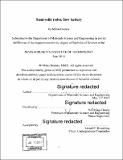Semi-solid redox flow battery
Author(s)
Duduta, Mihai
DownloadFull printable version (12.26Mb)
Other Contributors
Massachusetts Institute of Technology. Department of Materials Science and Engineering.
Advisor
Yet-Ming Chiang.
Terms of use
Metadata
Show full item recordAbstract
materials used in Li-ion batteries and the design and functioning of a redox flow cell. The use of Li-ion battery materials offers significant increases in energy and power density (200 Wh/kg compared to 25-35 Wh/kg for current commercial vanadium redox batteries). The implementation of a redox flow system allows for energy to be stored outside the cell and for the power and energy of the battery to be decoupled. A proof of concept is achieved by successful cycling of anode and cathode suspensions under intermittent flow conditions. The importance of materials' stability to cell life, energy and power densities is discussed. The high energy densities may enable the use of the proposed system in a variety of application, ranging from grid-level storage to fully electric charge.
Description
Thesis: S.B., Massachusetts Institute of Technology, Department of Materials Science and Engineering, 2010. Cataloged from PDF version of thesis. Includes bibliographical references (page 53).
Date issued
2010Department
Massachusetts Institute of Technology. Department of Materials Science and EngineeringPublisher
Massachusetts Institute of Technology
Keywords
Materials Science and Engineering.